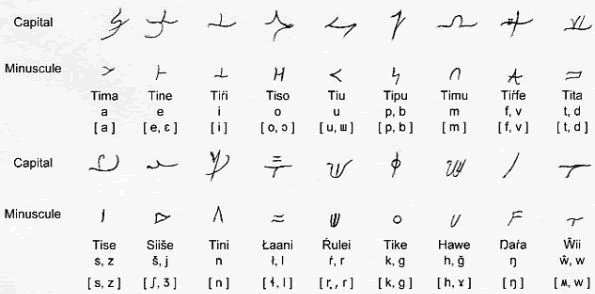h1>Šsioŵe Łuŵuŕ

The Šsioŵe Łuŵuŕ alphabet was created
in 2006 by Jacob Collard. The alphabet began as an alternative script for English
that was meant to be very compact but still easy to learn. However, the alphabet
was later used for writing a conlang that Jacob had been writing, and has rarely
been used for English since. The language has become the basis for a book that Jacob
has been writing, which currently has no definite title. The basis for the compact
writing is a square which can hold five or six letters depending on the first,
therefore using space more efficiently.
Notable Features
- Type of writing system: alphabet
- Direction of Writing: right to left in horizontal lines
- Used to write: Šsioŵe Łuŵuŕ
- There is distinction between capital and minimal letters. However, every square
of letters, instead of every sentence, begins with a capital letter. - Šsioŵe Łuŵuŕ requires no punctuation,
although it did exist in older forms of the alphabet. The only punctuation
ever used was an ‘x’ at the end of a sentence to represent a full stop. - A number of allophones are permitted. Digraphs ‘th,’ and ‘dh’ may be pronounced
either as dental fricatives or aspirated alveolar fricatives. E may be pronounced
as either [e] or as [ɛ].
The Cell Structure
The cell structure is, in Šsioŵe Łuŵuŕ, the
way that the letters combine into five-letter groups. One group is called a cloister
and one space that may hold a letter is called a cell.
- A cloister usually consists of five letters (cell). The first is placed centrally
and is in capital form. The rest are all minuscule with the first in the upper right
corner and the rest continuing in a counterclockwise direction. - With the letters representing ‘i,’ ‘m,’ ‘t,’ ‘s,’ and ‘ʃ’ occupying the
first cell, it is optional to have a sixth letter in the cloister. - There are no spaces between words. Instead, if one cloister is not sufficient,
a second will be joined to it with a curved line between the two. - A cloister never ends part-way through a syllable. Instead, all of the letters
of the syllable will be placed in the second cloister of the word.
Šsioŵe Łuŵuŕ Alphabet

Diacritics
There are also four digraphs: ‘io’ and ‘ea’ are pronounced as [ɪ] and [æ],
respectively. ‘Th’ and ‘dh’ may be pronounced as either aspirated alveolar plosives or
as dental fricatives, i.e. [tʰ] and [dʱ] or [θ] and [ð].

The ‘X’ shown represents any cloister.
There are four basic diacritics in Šsioŵe Łuŵuŕ,
all of them based on a curved stroke. All of them perform the same function, which is
to make a voiceless sound voiced, but they each affect a different cloister in the cell.
The primary diacritic voices the first cloister, the secondary voices the second cloister,
the tertiary the third, the quaternary the fourth, and the quinary the fifth. There is
also a senary diacritic, which voices the sixth cloister. The senary diacritic appears
the same as the primary except with a vertical line through the center.
Sample Text

Transliteration
Anam’Aŋ Ełie Šsioŵe Thorn Ši Eałan E
Teŕe T’ Tam Tamawe Kŵu Peath Emis Šsioŵe Wu Elewi
Eałan F’ Ŕin Tała Poŕau Anam’Aŋ Ši
Dhoše M’ Thorn Ts’ Šsioŵe Ts’ Elewi Mai Kŵu
Šsioŵe Thorn In Haian’Aale Unum’Uŋ Thorn Šeŵi
Me Ełie Ts’ Mi Wu Elewi Mai Elewi
Translation
All human beings are born free and equal in dignity and rights. They are endowed with reason
and conscience and should act towards one another in a spirit of brotherhood.
(Article 1 of the Universal Declaration of Human Rights)
